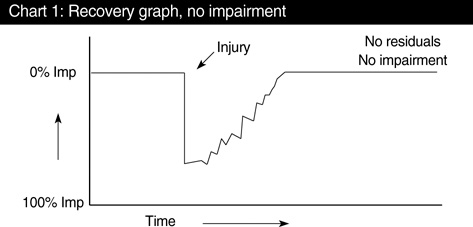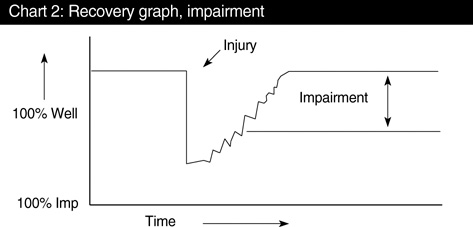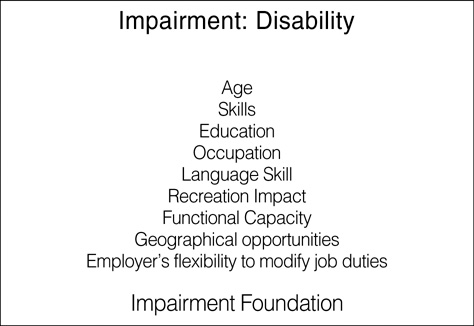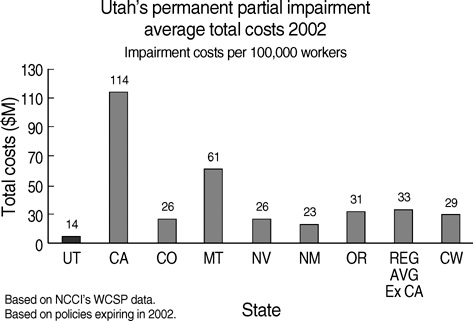J Korean Med Sci.
2009 May;24(Suppl 2):S232-S241. 10.3346/jkms.2009.24.S2.S232.
Impairment Rating Ambiguity in the United States: The Utah Impairment Guides for Calculating Workers' Compensation Impairments
- Affiliations
-
- 1Department of Orthopaedic, Central Utah Clinic, Labor Commission of Utah, Utah, USA. acolledge@utah.gov
- 2Department of Economics, Brigham Young University, Utah, USA.
- 3Division of Industrial Accidents, Utah Labor Commission, Utah, USA.
- 4Department of Family and Preventative Medicine, Rocky Mountain Center for Occupational Environmental Health, University of Utah, Utah, USA.
- KMID: 1713807
- DOI: http://doi.org/10.3346/jkms.2009.24.S2.S232
Abstract
- Since the implementation of workers' compensation, accurately and consistently rating impairment has been a concern for the employee and employer, as well as rating physicians. In an attempt to standardize and classify impairments, the American Medical Association (AMA) publishes the AMA Guides ("Guides"), and recently published its 6th edition of the AMA Guides. Common critiques of the AMA Guides 6th edition are that they are too complex, lacking in evidence-based methods, and rarely yield consistent ratings. Many states mandate use of some edition of the AMA Guides, but few states are adopting the current edition due to the increasing difficulty and frustration with their implementation. A clearer, simpler approach is needed. Some states have begun to develop their own supplemental guides to combat problems in complexity and validity. Likewise studies in Korea show that past methods for rating impairment are outdated and inconsistent, and call for measures to adapt current methods to Korea's specific needs. The Utah Supplemental Guides to the AMA Guides have been effective in increasing consistency in rating impairment. It is estimated that litigation of permanent impairment has fallen below 1% and Utah is now one of the least costly states for obtaining workers' compensation insurance, while maintaining a medical fee schedule above the national average. Utah's guides serve as a model for national or international impairment guides.
Keyword
MeSH Terms
Figure
Reference
-
1. Harger L. Workers' compensation, a brief history. State of Florida Division of Workers' Compensation. accessed 06 June 2008. Available at http://www.fldfs.com/WC/history.html .2. Williams CA. An International Comparison of Workers' Compensation. 1991. Boston, MA: Kluwer.3. Yaron R. The Laws of Eshnuna. Section 42. 1988. Jerusalem Leiden: The Magnes Press. The Hebrew University;69.4. Fischer DK. The Lombard Lm's. 1973. Philadelphia. PA: University of Pennsylvania Press;62.5. Colledge A, Sewell J, Hollbrook B. Impairment ratings in Utah: reduction of variability and litigation within workers' compensation. Disability Medicine. 2001. 1:16–27.6. U.S. Chamber of Commerce. 1997 Analysis of Workers' Compensation laws. 1997.7. Burton JF. Workers' compensation benefits paid to workers. John Burton's Workers' Compensation Monitor. 1996. 9:2.8. Swezey CL. Ladou J, editor. Workers' compensation law. Occupational Medicine. 1990. East Norwalk, CT: Appleton & Lange.9. Tait RC, Chibnall JT, Andresen EM, Hadler NM. Disability determination: validity with occupational low back pain. J Pain. 2006. 7:951–957.
Article10. Burton JF Jr. The AMA Guides and Permanent Partial Disability Benefits. IAIABC Journal. 2008. 45:13–34.11. Causey J, McFarren T, Nimlos J. The AMA 6th: Accelerating the Demise of Permanent Disability in Workers' Compensation. IAIABC Journal. 2008. 45:49–64.12. Colledge A, Krohm G. Rating of Impairments from Injury Impairment. IAIABC Journal. 2003. 4:32–48.13. Gloss DS, Wardle MG. Reliability and validity of American Medical Association's guide to ratings of permanent impairment. JAMA. 1982. 248:2292–2296.
Article14. Nitschke JE, Nattrass CL, Disler PB, Chou MJ, Ooi KT. Reliability of the American Medical Association guides' model for measuring spinal range of motion: its implication for whole-person impairment rating. Spine. 1999. 24:262–268.15. Clark WL, Haldeman S, Johnson P, Morris J, Schulenberger C, Trauner D, White A. Back impairment and disability determination, another attempt at objective, reliable rating. Spine. 1988. 13:332–341.16. Holmes EB. Impairment rating and disability determination. accessed 14 May 2008. Available at http://www.emedicine.com/pmr/topic170.htm .17. Spieler EA, Barth PS, Burton JF Jr, Himmelstein J, Rudolph L. American Medical Association. Recommendations to guide revision of the Guides to the Evaluation of Permanent Impairment. JAMA. 2000. 283:519–523.18. Greenough CG, Fraser RD. The effects of compensation of recovery from low-back injury. Spine. 1989. 14:947–955.19. Hunter SJ, Shaha S, Flint D, Tracy DM. Predicting return to work. A long term follow-up study of railroad workers after low back injuries. Spine. 1998. 23:2319–2328.20. Sander RA, Meyers JE. The relationship of disability to compensation status in railroad workers. Spine. 1986. 11:141–143.
Article21. Rainville J, Sobel JB, Hartigan C, Wright A. The effect of compensation involvement on the reporting of pain and disability by patients referred for rehabilitation of chronic low back pain. Spine. 1997. 22:2016–2024.
Article22. Guest GH, Drummond PD. Effect of compensation on emotional state and disability in chronic back pain. Pain. 1992. 48:125–130.
Article23. Jamison RN, Matt DA, Parris WC. Effects of time, limited vs. unlimited compensation on pain behavior and treatment outcome in low back pain patients. J Psychosom Res. 1988. 32:277–283.24. Leavitt F. The physical exertion factor in compensable work injuries; a hidden flaw in previous research. Spine. 1992. 17:307–310.25. Milhous RL, Haugh LD, Frymoyer JW, Ruess JM, Gallagher RM, Wilder DG, Callas PW. Determinants of vocational disability in patients with low back pain. Arch Phys Med Rehabil. 1989. 70:589–593.26. Fredrickson BE, Trief PM, VanBeveren P, Yuan HA, Baum G. Rehabilitation of the patient with chronic back pain: a search for outcome predictors. Spine. 1988. 13:351–353.27. Guck TP, Meilman PW, Skultety FK, Dowd ET. Prediction of long-term outcome of multidisciplinary pain treatment. Arch Phys Med Rehabil. 1986. 67:293–296.28. Leigh JP, Markowitz SB, Fahs M, Shin C, Landrigan PJ. Occupational injury and illness in the United States: estimates of cost, morbidity and mortality. Arch Intern Med. 1997. 157:1557–1568.29. Berkowitz M, Burton JF Jr. Permanent disability benefits in workers' compensation. 1987. Kalamazoo, MI: W.E. Upjohn Institute for Employment Research.30. American Medical Association guides to the evaluation of permanent impairment. 1971. Chicago, IL: American Medical Association.31. 2nd edition of AMA guides to the evaluation of permanent impairment. 1984. Chicago, IL: American Medical Association.32. 3rd edition of AMA guides to the evaluation of permanent impairment. 1988. Chicago, IL: American Medical Association.33. 3rd revised edition of AMA guides to the evaluation of permanent impairment. 1990. Chicago, IL: American Medical Association.34. 4th edition of AMA guides to the evaluation of permanent impairment. 1993. Chicago, IL: American Medical Association.35. 5th edition of AMA guides to the evaluation of permanent impairment. 2001. Chicago, IL: American Medical Association.36. Return to work patterns for permanently impaired workers. Texas Monitor. 1996. 1:7–8.37. Brigham C. Impairment Resource Discussions. accessed 6 June 2008. Available at http://www.impairment.com/use_of_AMA_guides_maps.htm .38. Hall LB. New Hampshire-Analysis of AMA guides. 2008. 05. 02. 6th edition. Plainfield, VT: National Council on Compensation Insurance, Inc.39. Hall LB. Vermont-Analysis of AMA guides. 2008. 05. 02. 6th edition. Plainfield, VT: National Council on Compensation Insurance, Inc.40. Hall LB. Rhode Island-Analysis of AMA guides. 2008. 05. 02. 6th edition. Plainfield, VT: National Council on Compensation Insurance, Inc.41. Walleser HM. 2008 Iowa AMA Guides task force process report. accessed 6 June 2008. Available at http://www.iowaworkforce.org/wc/amataskforce/2008amaguidesprocessreport.pdf .42. Causey J, McFarren T, Nimlos J. The AMA 6th: Accelerating the Demise of Permanent Disability in Workers' Compensation. IAIABC Journal. 2008. 45:49–64.43. Brigham C. AMA guides 6th edition: new concepts, challenges, and opportunities. IAIABC Journal. 2008. 45:13–57.44. Guides to the Evaluation of Permanent Impairment, Sixth Edition, Clarifications and Corrections. accessed 6 June 2008. Available at www.ama-assn.org/ama1/pub/upload/mm/477/guidesclarifications.pdf .45. McFarren T. AMA guides, sixth edition arrive on the scene. Workers First Watch. 2008. 1:3–6.46. Colledge A. Is splitting up booty turning into a mutiny? Occup Health Saf. 1994. 63:30–34.47. Patel B, Buschbacher R, Crawford J. National variability in permanent partial impairment ratings. Am J Phys Med Rehabil. 2003. 82:302–306.
Article48. Leigh JP, McCurdy SA. Differences in workers' compensation disability and impairment ratings under old and new California law. J Occup Environ Med. 2006. 48:419–425.
Article49. Robinson JP, Turk DC, Loeser JD. Pain, impairment, and disability in the AMA guides. J Law Med Ethics. 2004. 32:315–326.
Article50. Bonner R. AMA Guides-Challenges in Application. IAIABC Journal. 2008. 45:93–107.51. Impairment rating guide. 1997. Salt Lake City, UT: Utah Labor Commission.52. Nachemson AL. White AA, Gordon SL, editors. The natural course of low back pain. 1982. St. Louis, MO: Mosby.53. King PM, Tuckwell N, Barrett TE. A critical review of functional capacity evaluations. Phys Ther. 1998. 78:852–866.
Article54. Gross DP, Battié MC, Cassidy JD. The prognostic value of functional capacity evaluation in patients with chronic low back pain: part 1: timely return to work. Spine. 2004. 29:914–919.55. Gross DP, Battié MC. The prognostic value of functional capacity evaluation in patients with chronic low back pain: part 2: sustained recovery. Spine. 2004. 29:920–924.56. Rhee CO, Choi JK, Son MA, Moon OR. A comparative study on evaluation methods of permanent impairment in Korea. Korean J Prev Med. 1994. 27:627–651.57. Li Z, Kang SH, Lee SD. Review of Korean disability evaluation systems and suggestions for the improvement direction. Korean J Leg Med. 2007. 31:16–30.
- Full Text Links
- Actions
-
Cited
- CITED
-
- Close
- Share
- Similar articles
-
- A Review of the AMA Guides to the Evaluation of Permanent Impairment
- A Comparative Study on Evaluation Methods of Permanent Impairment in Korea
- A Korean Academy of Medical Sciences Guides for the Evaluation of Permanent Impairment
- Development of the Korean Academy of Medical Sciences Guideline for Rating Physical Impairment
- A Study on the Degree of Impairment of Whole Person in Leprosy Patients





